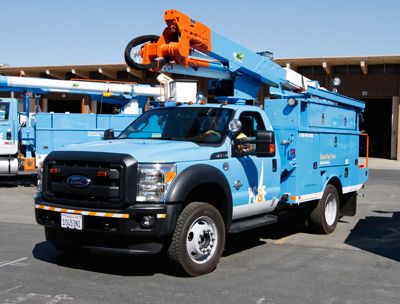
Preventive Maintenance and the Electric Vehicle
In an effort to reduce fuel costs, extend replacement cycles and lower greenhouse gas emissions, an increasing number of utility fleets now operate electric vehicles (EVs). In fact, in November 2014, the White House and Edison Electric Institute announced that more than 70 U.S. electric utility companies have plans to devote at least 5 percent of their fleet acquisition budgets to buying plug-in EVs and related technology. Their investments will total approximately $50 million each year.
With fewer moving parts and less reliance on oil to lubricate and help cool the engine parts that do move, EVs represent a sound investment, over time, for many utility fleets. In addition to lower fuel costs and fewer emissions, others benefits of operating EVs include reduced noise levels, exportable power and lower total cost of ownership.
“While you pay more for a plug-in, the overall cost of ownership is significantly lower,” said David Meisel, senior director of transportation and aviation services at Pacific Gas and Electric (PG&E), explaining that payback for the company’s fleet usually ranges from two to seven years. “For our bucket trucks, we’re looking at paybacks in 24 to 30 months. Some of our light-duty applications pay back in five years or less. And some of our pickup trucks see payback in seven years.”
All Maintenance Programs Are Not Equal
By developing an effective preventive maintenance plan and sticking to it, companies can expect longer life for the EVs in their fleets. This means fleet managers do not have to replace vehicles as often, generating even more savings when added to the decreased costs of operating EVs. In addition to a great return on investment, companies that operate EVs can lower their environmental footprints as well.
But should maintenance schedules for EVs be the same as their gas and diesel counterparts, and how can you adequately protect and ensure the long life of your EV fleet?
The PG&E fleet operates about 1,400 EVs out of a total fleet of 14,000. The fleet’s EVs range from Chevy Volts to Ford Fusions to GMC Sierras, among many others. According to Meisel, the key to an effective EV maintenance program is to recognize that all EVs are not equal – they are application specific. So, maintenance schedules must be unique for EVs.
“If fleet managers don’t treat them differently, they are missing out on a big opportunity,” Meisel explained. “If they run the same preventive maintenance program for EVs as their other vehicles, they are leaving a tremendous amount of money on the table and forgoing the benefits of electrification.”
Preventive Maintenance Best Practices for Utility EVs
Unlike traditional internal combustion vehicles, EVs rely on electricity to power the various systems that make them go. But because EVs still use some moving parts, effective maintenance can help keep them in proper working order. This means that, in addition to any lubricants and other fluids associated with traditional vehicle maintenance, fleet managers should also design schedules centered on maintaining the vital electric components of an EV’s drivetrain. And of course, fleet managers should follow the manufacturer’s recommended maintenance schedule for best results.
Training mechanics also is critical to the preventive maintenance process, not only to keep parts properly maintained, but to ensure the safety of all personnel. “The voltage on these vehicles can kill. It’s very important that those who work on them are specially trained,” Meisel said. “We train all our mechanics on high-voltage EV systems because safety is first and foremost.”
As far as set maintenance schedules for EVs, in PG&E’s case the EV components essentially are worry-free, with a few more connections to look at and possible wear on lines. And according to Meisel, fleet management has drastically extended its preventive maintenance in many areas, including oil changes and brake work. “The maintenance intervals are significantly longer because of the durability of the systems,” he said.
Meisel pointed out that it is best practice to adhere to regular preventive maintenance schedules even though EVs do not require as much maintenance as their gas and diesel counterparts. “For our electric vehicles, we are finding that we can drastically extend our preventive maintenance. For instance, for some vehicles we do oil changes only once per year; for others, every 15 years. Not because they need it, but because it’s time.”
PG&E’s fleet management is also finding that EVs used in urban areas are seeing brakes lasting two to three times longer, thanks to regenerative braking. “Our maintenance work on our brakes has dropped drastically,” Meisel explained.
He summed up PG&E’s experience with EV maintenance by stating, “Our experience is that EVs are extremely bulletproof from a maintenance perspective.”
About the Author: Cheryl Knight has written for the fleet industry for more than 20 years. Her work has appeared in Automotive Fleet, Fleet Financials, Government Fleet and a number of other niche-market publications.
*****
Learn More
In June 2014, Edison Electric Institute published “Transportation Electrification: Utility Fleets Leading the Charge,” which provides a wealth of information about the benefits of electrification, vehicle technology, total cost of ownership and much more. A copy of the white paper can be found at www.eei.org/issuesandpolicy/electrictransportation/FleetVehicles/Documents/EEI_UtilityFleetsLeadingTheCharge.pdf.


